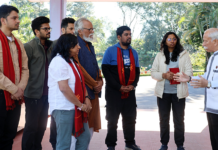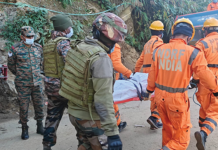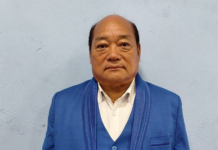[ Tongam Rina ]
A circular issued by the Siang district administration regarding the arrangement of accommodation for the Central Armed Police Forces (CAPF) at Riew village, in the context of the pre-feasibility report (PFR) of the Siang Upper Multipurpose Project (SUMP), has strongly provoked those opposed to theconstruction of the mega hydropower project on the revered Siang river.
Not long ago, on 19 August, 2024, the special branch of the state police headquarters directed the Pasighat branch to assess security threats related to the survey and core drilling for the project. The identified drilling locations were Parong, Dite Dime, and Uggeng. The villagers carried out huge protests during that time.
The aggressiveness with which the Pema Khandu government is pushing forward with the Siang dam is both frighteningly alarming and reckless.
It has used every trick in the book to intimidate the villagers, including the leaders of Siang Indigenous Farmers’ Forum (SIFF). Anti-dam activist Ebo Mili and SIFF convener Dunge Apang were arrested in July while the union power minister was on a visit to Itanagar.
In a state where conflicts over hydroelectric projects have often turned violent – from Dibang to Tawang to Siang – it is only prudent for the government to proceed with caution, not arrogance. Deploying armed police and conducting late-night investigations is daring the people to protest and provokes violence. This approach should be avoided. The decade-long resistance in Dibang was brutally crushed by force and coercion, targeting not only student leaders but villagers as well. Is the government trying to apply the same tactics in Siang? It certainly seems so. The SIFF is not some fly-by-night anti-dam organisation; it has mobilised the masses as seen in previous protests in August. Therefore, the government must refrain from its aggressive and intimidating stance of sending central security forces.
A government that refuses to listen to the people will inevitably face the consequences of its actions. The government should ask itself: Why are people protesting, even though there’s significant monetary benefits to be made from the project?
Such utter disregard for indigenous communities and the use of state brutality is not new in the state, but it is unacceptable. The government is on a confrontational path, unwilling to engage in meaningful dialogue. It just wants to crush any opposition.
The earlier diktat barring government employees from participating in protests is a sign of things to come and demonstrates how far the state is willing to go to crush the anti-mega dam movement that has been ongoing for decades.
As reported earlier, the Upper Siang and Siang district administrations had barred gaon burahs, gaon buris, and other government employees from participating in protests against the dams, provoking strong resentment among those opposed to the dam, who view this as clear intimidation.
Instead of conducting a pre-feasibility study while the citizens are divided – with more opposing the dam than supporting it – the government should consider holding a gram sabha in all the villages, upstream and downstream, if it is genuinely serious about listening to the people.
The first step should be addressing the fears and concerns of the people. How can the government even contemplate damming an entire river without first holding mass meetings?
Hiding behind the discourse of national security, at the cost of irreparable environmental destruction and the probable displacement of its own citizens, the government has been extremely reluctant to engage directly with the communities. It should at least attempt to explain logically why it needs to counter the Chinese threat by building a dam downstream against the wishes of the local communities.
Not long ago, the Rajya Sabha was informed that local villagers had raised concerns over the Upper Siang Multipurpose Project. The power minister said that “these concerns are being addressed through confidence-building measures and outreach activities.”
I fail to understand how confidence is built by bringing in trigger-happy security forces to a site where studies are being carried out to counter peaceful protests. It is a direct warning to the citizens to stay away from any form of protest.
In a state like Arunachal, which is peaceful yet can become extremely volatile in a short time, one must be cautious. Do not rely too heavily on a few leaders or the special branch reports, because most of the time, they are out of touch with reality. Unlike before, when protests were isolated, social media now enables messages to spread quickly, even through a simple WhatsApp voice note. It is hard to understand why, before taking such provocative actions, the political leadership does not remember the time when the government ignored the people’s fears – when it was drunk on power and arrogance – leading to protests over the permanent resident certificate (PRC) issue in 2019. That was a massive intelligence failure that brought the government to its knees, with deaths and destruction everywhere. With such a history, there seems to be no justification for the government’s refusal to listen to the people. Even the Tawang violence, which claimed three lives and maimed many in protests against hydroelectric dams, was not too long ago.
Siang needs to be handled with care, caution, and respect.
The government’s initial plans for the Lower Siang HEP (2,700 mw) and the Siang Upper HEP Stage-II (3,750 mw) had already faced resistance for more than two decades. Amid growing fears and opposition, the capacity was expanded to 11,000 mwwithout new studies, triggering a wave of protests.
Earlier, the NITI Aayog had proposed a 10,000 mwSiang project, aiming to build a single multipurpose river valley project on the Siang river, featuring a 300-metre-high dam and a power generation capacity of 10,000 mw to “moderate floods and erosion, providing relief in downstream river reaches of Arunachal and Assam.”
It is unbelievable how fast everything on the Siang is unfolding, all in the name of countering China, while giving little thought to the cascading effects on the local environment and citizens. The only consistent factor has been the opposition from a large number of people. No government will succeed in nation-building and national security if it undermines the rights of indigenous people, who have been the guardians not only of resources but also of national security.
Does the chief minister remember his own statement made during a public meeting in January 2024, where he said that the proposed Siang hydropower project would only proceed after consultations and obtaining the consent of the people? What makes politicians forget promises and assurances so quickly? It seems the only people consulted have been the elected representatives. If the Siang project is too complicated to understand, Tawang, his home district, should be a reminder that elections and local issues are completely different matters. People may vote for him, his candidates, and his party, but still be adamantly opposed to the hydro project.
Therefore, caution is needed – not armed central security forces. Provocation is not the answer. We are talking about a project that will have irreversible ecological impacts and long-term effects on local communities, including displacement, if at all it comes up. The Siang river has nourished the people, their culture, and their history for centuries. Do not incite a river with guns. Go slow.





